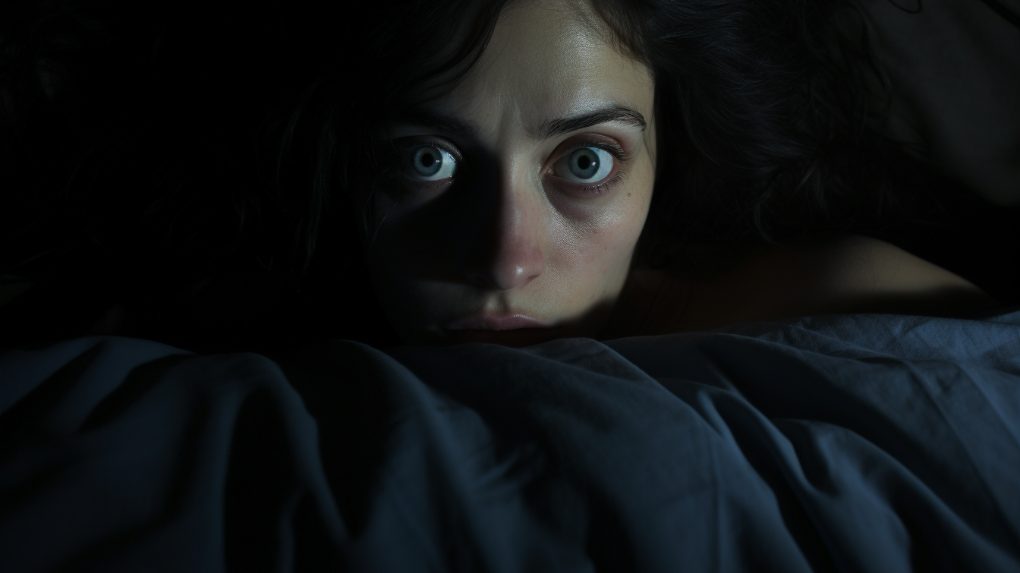Navigating the shadowy realms between consciousness and the dream world, individuals often encounter the enigmatic and uncanny phenomenon known as hypnopompic hallucinations.
These intricate sensory deceptions, manifesting in the twilight moments before awakening, beckon with a siren’s call into a labyrinth where reality and illusion indistinguishably intertwine. Within this detailed expedition, we unravel the tapestry of these elusive experiences, journeying through their deep connections with REM sleep and their cryptic crossovers with various sleep disorders.
Prepare to embark on a cerebral odyssey that illuminates the haunting beauty and perplexing dilemmas posed by these phantoms of the waking mind.
Understanding Sleep-Related Hallucinations
In the realm of sleep disorders, hallucinations hold a particularly unsettling position. These sensory experiences can mimic reality in vivid detail, yet they occur without any external stimulus, often blurring the lines between sleep and wakefulness.
Defining Hypnopompic Hallucinations
Hypnopompic hallucinations occur in the transitional state from sleep to wakefulness. Unlike daytime hallucinations associated with certain mental health conditions, these phenomena are intrinsically tied to the sleep-wake cycle. Individuals may experience visual, auditory, or other sensory hallucinations that are often vivid and may be disturbing. Although these hallucinations do not inherently indicate an underlying mental illness, their presence necessitates a thorough examination to understand the interconnected health implications.
Distinction Between Hypnagogic and Hypnopompic Hallucinations
It’s crucial to distinguish between hypnagogic and hypnopompic hallucinations. The former occur as one falls asleep (sleep onset), while the latter manifest upon waking. This distinction is vital for sleep medicine, as it aids in pinpointing the underlying disorder influencing the sleep disturbances. Both types can be profoundly disorienting, compounding individuals’ distress when experiencing these phenomena.
Related: Breaking Through Sleep Paralysis – Finding Strategies To Overcome It
The Science of Hypnopompic Imagery
Delving into these hallucinations’ neurological and psychological underpinnings provides insights into why they occur. The brain’s activity during different sleep stages, particularly REM sleep, is a central focus, as it sets the stage for potential hallucinatory experiences.
Relationship with REM Sleep
Rapid eye movement (REM) sleep is often associated with vivid dreaming, but its link with hypnopompic hallucinations is equally noteworthy. During REM sleep, the brain exhibits activity similar to that seen during wakefulness. However, muscle atonia prevents individuals from acting out their dreams. Problems in the transition out of REM sleep can cause remnants of dreams to invade waking consciousness in the form of hypnopompic hallucinations, effectively bridging the gap between the dream world and reality.
Dissecting the Sleep Period: NREM and REM Sleep States
Understanding the intricacies of the sleep period is essential in dissecting phenomena such as hypnagogic and hypnopompic hallucinations. Sleep is divided into non-REM (NREM) sleep stages and REM sleep states, each characterized by unique physiological processes.
NREM Sleep: The Foundation of Rest
NREM sleep, often associated with physical restoration, comprises the majority of the sleep period. It’s during these non-REM sleep stages that the body undergoes most of its repair and regeneration. Complex hallucinations are less common in these stages; however, brief hallucinations might still occur, often less vivid than those experienced during REM sleep.
REM Sleep: Where Dreams Occur
REM sleep is where most dreaming happens, and it’s also the state associated with an increased likelihood of experiencing hallucinations. The paralysis that typically accompanies REM sleep prevents us from acting out our dreams, but disruptions in these mechanisms might contribute to vivid, complex visual or auditory hallucinations, as the person feels awake, yet the dream continues outside the bounds of sleep.
How Sleep Disorders Influence Hallucinations
Sleep disorders disrupt the normal sleep-wake cycle, potentially heightening the propensity for hallucinations. Conditions such as sleep apnea, night terrors, or REM sleep behavior disorder directly interfere with sleep architecture. For instance, fragmented sleep can lead to abrupt awakenings during REM sleep, making it more likely for dream content to surface as hallucinations. Narcolepsy, characterized by excessive daytime sleepiness and sudden loss of muscle tone, is another disorder where hypnopompic and hypnagogic hallucinations frequently occur, further illustrating the intricate relationship between sleep patterns and hallucinatory experiences.
Related: How Long Are Dreams – Understanding the Different Lengths of Dreams
Common Examples and Patterns of Hypnopompic Hallucinations
Recognizing commonalities in hypnopompic hallucinations helps demystify these experiences. While they can be highly individualistic, certain patterns tend to surface, offering insights into their nature and potential triggers.
Visual Hallucinations
Visual hallucinations are among the most reported in the hypnopompic state. Individuals often describe seeing complex visual hallucinations, including shapes, patterns, or figures, sometimes with a clarity that mimics reality. These hallucinations can range from pleasant to disturbing imagery, significantly impacting an individual’s emotional state upon waking.
Auditory Hallucinations
Experiencing auditory hallucinations, such as hearing voices or sounds that don’t exist, can be particularly unsettling. These can manifest as indistinct whispers, clear voices, or nonsensical sounds, often seeming as real as any sound heard during full wakefulness. The content can be neutral, but it may also be threatening or derogatory, contributing to post-awakening anxiety.
Tactile Sensations
Hypnopompic experiences aren’t limited to sight and sound; tactile sensations are also reported. People may feel as if something is touching or crawling on them, or they might experience pressure, often in the absence of any physical stimulus. This type of hallucination can be especially disturbing, as the perceived invasion of personal space adds an element of discomfort beyond mere observation.
Intersection with Other Sleep Phenomena
Hypnopompic hallucinations don’t exist in isolation; they often intersect with other sleep-related phenomena. Understanding these connections highlights the multifaceted nature of sleep disorders and their broader implications for mental health.
Sleep Paralysis and Hallucinations
One of the most anxiety-provoking sleep experiences, sleep paralysis, often accompanies hypnopompic hallucinations. During these episodes, individuals awaken to find themselves unable to move or speak, coupled with a feeling of a heavy chest or restricted breathing. Hallucinations — visual or auditory — may compound the fear. The state of heightened vulnerability can make any accompanying hallucinatory experience seem particularly vivid and threatening.
Night Terrors, Lucid Dreaming, and Hallucinations
The lines between night terrors, lucid dreams, and hypnopompic hallucinations can blur. Night terrors, characterized by intense fear and a scream or shout upon awakening, differ from nightmares and can segue into hallucinatory experiences. Lucid dreaming, the awareness of dreaming while a dream is occurring, allows for some level of control within the dream. When lucid dreams transition abruptly into the waking state, the remnants of the dream can manifest as hypnopompic hallucinations, extending the dream’s narrative into perceived reality.
Also read Is Lucid Dreaming Dangerous? – What You Need To Know Before Trying It Out
Diagnosis of Hypnopompic Hallucinations
Effectively addressing hypnopompic hallucinations begins with a thorough and accurate diagnosis. Distinguishing these episodes from underlying disorders or other sleep-related symptoms is critical for formulating an appropriate treatment approach.
Role of Sleep Medicine
In the field of sleep medicine, professionals employ a variety of tools to understand the complexities of a patient’s sleep patterns. Polysomnography, a type of sleep study, is often instrumental in diagnosing disorders that could contribute to hallucinations, such as REM sleep behavior disorder or sleep apnea. These conditions can disrupt sleep stages, potentially precipitating hallucinatory experiences.
Utilizing the Multiple Sleep Latency Test
The Multiple Sleep Latency Test (MSLT) serves to measure the speed at which a person enters different sleep stages. It’s particularly relevant for conditions like narcolepsy, where rapid onset of REM sleep can contribute to hypnagogic and hypnopompic hallucinations. Understanding the nuances of these transitions helps identify abnormalities and guides the therapeutic process.
Bridging Sleep and Consciousness: The Hypnagogic State
The hypnagogic state, occurring as individuals transition from wakefulness to sleep, is often where hypnagogic hallucinations happen. As one is falling asleep, this stage may host a range of sleep-related experiences, from the mundane to the bizarre.
The Mystery of Hypnagogic Hallucinations
Despite their common occurrence, much about hypnagogic hallucinations remains enigmatic. Often more vivid and bizarre than hypnopompic hallucinations, these experiences can involve sensations of floating, falling, or even muscle weakness. Such hallucinations, although startling, are typically benign, though they can be distressing and confusing as they blur the line between reality and dreams.
Consulting with a Sleep Specialist
When these experiences become a source of distress or fear, consulting with a sleep specialist is recommended. These experts can differentiate between simple sleep-related hallucinations and symptoms of a more serious sleep disorder or mental health condition. They rely on detailed patient histories, coupled with tools like sleep studies, to diagnose and recommend appropriate treatments or coping strategies.
Related Article What Happens When You Don’t Get Enough Sleep?
Psychological Perspectives on Sleep Hallucinations
The intersection of sleep and psychology is evident when hallucinations manifest. Analyzing these from a psychological viewpoint opens avenues for holistic treatment, addressing both sleep disruption and mental well-being.
Mental Health and Its Influence
Mental health conditions, including anxiety and mood disorders, often exacerbate sleep problems. Stress and psychological turmoil can interrupt sleep, leading to fragmented patterns that increase the likelihood of hypnopompic episodes. Furthermore, individuals with a history of trauma may experience more intense and distressing content in hallucinations, reflecting their psychological distress.
Hallucinations in Psychiatric Disorders
In certain psychiatric disorders, such as schizophrenia or delusional psychosis, hallucinations are a prominent feature. However, these are distinct from hypnopompic hallucinations, as they are not confined to the transitional periods of sleep. Yet, the occurrence of hypnopompic hallucinations can cause additional distress for individuals already coping with psychiatric symptoms, necessitating an integrated approach to care that considers both sleep quality and mental health management.
Hallucinations and Mental Health: Deciphering Complex Experiences
The interplay between sleep and mental health is complex. Conditions such as schizophrenia, detailed in publications like the Schizophrenia Bulletin, highlight the severe end of hallucinatory experiences, where distinguishing between such hallucinations and psychopathological ones becomes crucial.
Recognizing Serious Symptoms
In certain sleep disorders, hallucinations are just one component of a broader spectrum of symptoms. For instance, narcolepsy can involve sleep paralysis, hallucinations, and excessive daytime sleepiness. Other symptoms might include disruptions in sleep architecture, impacting both the quantity and quality of sleep an individual gets.
The Importance of Adequate Sleep
Achieving enough sleep is a cornerstone of maintaining balanced mental health. Sleep deprivation can precipitate hallucinations or exacerbate pre-existing mental health conditions, emphasizing the need for consistent sleep schedules and good sleep hygiene.
Day-to-Day Impact and Management
Chronic hallucinations can severely impact daily life, whether hypnopompic or associated with an underlying disorder. Management strategies often require addressing both the direct and indirect consequences of these experiences.
Excessive Daytime Sleepiness and Fragmented Sleep
One of the most immediate impacts of frequent hypnopompic hallucinations is on sleep quality. Individuals may experience sleep disturbances and subsequent excessive daytime sleepiness, affecting their concentration, work performance, and overall quality of life. Fragmented sleep, a common consequence, can perpetuate a cycle of stress and sleep disruption, further ingraining the pattern of hallucinatory experiences.
Coping with Anxiety-Provoking Experiences
Hypnopompic hallucinations can be particularly anxiety-provoking, leaving individuals feeling unsettled or frightened upon waking. Coping strategies often involve grounding techniques, such as mindfulness or focused breathing, to help differentiate between hallucinations and reality. Maintaining a journal that details the nature of the hallucinations, accompanying feelings, and triggers can also aid individuals in establishing patterns and gaining a sense of control.
Professional Intervention and Therapy
When hallucinations significantly impair daily functioning or contribute to ongoing fear and anxiety, professional intervention becomes necessary. Therapists can employ various techniques, like cognitive-behavioral therapy (CBT), to help individuals challenge the irrational fear surrounding their experiences and develop coping strategies. In severe cases, where underlying mental health conditions are present, a psychiatrist might prescribe medication to manage the disorder, subsequently alleviating sleep-related hallucinations.
Don't miss Sleep Paralysis In Movies – Documenting Its Scary Portrayal in Films
Prevention Strategies and Good Sleep Hygiene
Preventing hypnopompic hallucinations often involves addressing sleep disorders and improving overall sleep quality. Consistent sleep hygiene practices are central to these preventive efforts.
Importance of Sleep Hygiene
Good sleep hygiene encompasses practices and habits that are conducive to sleeping well on a regular basis. These include maintaining a consistent sleep schedule, creating a comfortable sleep environment, and avoiding caffeine and electronic screens before bedtime. By optimizing sleep, individuals can potentially reduce the frequency and intensity of hypnopompic hallucinations, given the strong correlation between sleep quality and these unsettling experiences.
Relaxation Techniques and Environment Optimization
Relaxation techniques such as progressive muscle relaxation or guided imagery can prepare the mind and body for sleep, making it easier to fall asleep and potentially reducing the occurrence of hallucinations. Additionally, optimizing the sleep environment — ensuring the room is dark, quiet, and at a comfortable temperature, and using the bed only for sleep — can reinforce the association between bed and sleep, encouraging a smoother transition between sleep stages.
The Role of Underlying Disorders in Sleep-Related Hallucinations
Addressing any underlying disorder is crucial in managing sleep-related hallucinations. These experiences rarely occur in isolation and are often symptomatic of broader health issues.
Identifying and Treating Underlying Conditions
It’s essential for healthcare professionals to identify any conditions that may contribute to sleep disturbances. This process might involve a comprehensive medical evaluation, mental health assessment, and possibly neurological testing to rule out conditions that could be instigating the hallucinations. Appropriate management of these underlying issues is often instrumental in alleviating sleep-related hallucinations.
Ongoing Management and Support
For individuals experiencing hypnopompic hallucinations, ongoing support is key. This may involve regular check-ins with a healthcare provider, continuous therapy if needed, and perhaps participation in support groups for those with similar experiences. This continuous approach helps manage symptoms, provides a platform for sharing effective coping strategies, and reinforces the notion that individuals are not alone in their experiences.
Concluding Thoughts on Hypnopompic Hallucinations
Hypnopompic hallucinations, a phenomenon often overshadowed by the more frequently discussed hypnagogic counterparts, merit serious attention and understanding due to their potential impact on individuals’ well-being. These complex experiences, manifesting across various sensory modalities, are more than just vivid remnants of dreams. They are a psychological and physiological intersection that can significantly disrupt daily life, contributing to a cycle of stress and sleep disruption.
Understanding and Empathy
Misconceptions about hypnopompic hallucinations can lead to dismissive attitudes, further complicating the individual’s experience. A nuanced understanding is crucial, recognizing these occurrences not as mere oddities but as indicators of possible sleep disturbances or mental health conditions. Empathy towards individuals experiencing these phenomena is necessary, as is the avoidance of stigmatizing such experiences.
Holistic Approach to Management
Management strategies for hypnopompic hallucinations should be holistic, addressing the hallucinations themselves and potential underlying causes. This approach includes proper sleep hygiene, stress management, and professional intervention. For individuals undergoing such experiences, personalized coping strategies, from grounding techniques to professional therapy, can reduce anxiety and improve sleep quality.
Importance of Further Research
While much has been explored, further research is imperative. Continued studies in sleep medicine, psychology, and neuroscience could provide deeper insights into why these hallucinations occur, who is most susceptible, and how they can be effectively treated or managed. As our understanding evolves, so too will the strategies to support those who find their mornings clouded by these unsettling experiences.
In conclusion, hypnopompic hallucinations represent a significant aspect of human sleep behavior, one that intertwines with various facets of our health. Continued exploration and empathy in addressing these experiences are steps forward in the journey toward ensuring comprehensive care and support for all individuals.



